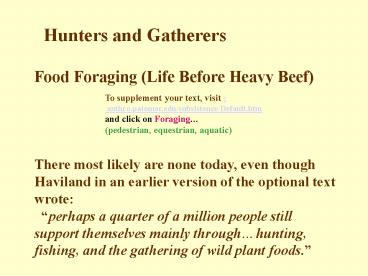Food Foraging (Life Before Heavy Beef)?
1 / 16
Title:
Food Foraging (Life Before Heavy Beef)?
Description:
Hunters and Gatherers Food Foraging (Life Before Heavy Beef) To supplement your text, visit : anthro.palomar.edu/subsistence/Default.htm and click on Foraging –
Number of Views:116
Avg rating:3.0/5.0
Title: Food Foraging (Life Before Heavy Beef)?
1
Hunters and Gatherers
Food Foraging (Life Before Heavy Beef)?
To supplement your text, visit
anthro.palomar.edu/subsistence/Default.htm and
click on Foraging (pedestrian, equestrian,
aquatic)
There most likely are none today, even though
Haviland in an earlier version of the optional
text wrote perhaps a quarter of a million
people still support themselves mainly
throughhunting, fishing, and the gathering of
wild plant foods.
2
Hunters and Gatherers
- Food Foraging (Hunting and Gathering)?
An approach to understanding ourselves is to
understand food foragers.
Julian Steward and Cultural Ecology Emphasis
is on the relationship between technology and
environment.how resources are recognized and
used.how this interaction affects other aspects
of culture and society.
Important to understand.We were all living in
food foraging societies until about 10,000 years
ago.before the Neolithic Revolution. Since then
everyone depends on domesticated species.
Often cited societies include the Bushmen of
Southern Africa, Aborigines of Australia, and
Eskimo of the Arctic.
The basic idea in modern psychological
anthropology is that we are essentially hunters
and gatherers in a post-industrial world.
We depend on imperfect studies of ethnographies
of societies largely dependent on food foraging
and on interpretations of archeological evidence.
3
Food Foraging Societies (Hunters and Gatherers)?
- Food Foraging (Hunting and Gathering)?
- Semi Nomadic (Tethered Nomads)?
- Occupy Distinct Area (Domain)?
- Population Size Stabilizes near the Maximum Long
Term Carrying Capacity of Domain
Carrying Capacity - number of individuals who
can be supported at a given level of technology.
4
(No Transcript)
5
Food Foraging Societies
(Hunters and Gatherers)?
All societies without domestication for food.
Domain
Endogamy/Exogamy
Dialectal culture
Basic division of labor - Men hunt Women
gather
Very efficient.among most leisured people
workweek about 20 hours/week
6
Food Foraging Societies
(Hunters and Gatherers)?
Food Foraging (Life Before Heavy Beef)?
Hunting and gathering, collecting, trapping,
fishing, etc.
If we assume Women have average of 5 children
who live to weaning Children are often suckled
until the age of 5 Women walk an average of 7
miles per day There are ca. 365 Days per year,
therefore 5 X 5 X 7 X 365 ca. 63,875 miles a
woman in a foraging society walks carrying a
child.
Domain (territory) must supply all subsistence
resources.
People lived in small, local, patrilineal bands.
Basic division of labor Men hunt Women gather.
The Basic Problem in Hunting and Gathering
Societies What Do Men Do? They Go Hunting!
7
Hunting and Gathering Societies
Central Ideas (Leda Cosmides and John Tooby)?
The brain is a physical system designed to
generate behavior that is appropriate to
environmental circumstances.
Modules for language, sexual attraction, emotion,
mapping, etc.
Our neural circuits were designed by natural
selection to solve problems that our ancestors
faced during our species' evolutionary history.
William James called this instinct blindness.
Consciousness is just the tip of the iceberg
most of what goes on in your mind is hidden.
Different neural circuits are specialized for
solving different adaptive problems.
In short, we are hunter-gatherers in a modern,
post industrial world.
Our modern skulls house a stone age mind.
8
Tabula rasa
Palimpsest
The Blank Slate has also served as a sacred
scripture for political and ethical beliefs.
According to the doctrine, any differences we see
among races, ethnic groups, sexes, and
individuals come not from differences in their
innate constitution but from differences in their
experiences. Change the experiencesby reforming
parenting, education, the media, and social
rewards and you can change the person.
Underachievement, poverty, and antisocial
behavior can be ameliorated indeed, it is
irresponsible not to do so
A palimpsest is a manuscript on which an earlier
text has been effaced and the vellum or parchment
reused for another. It was a common practice,
particularly in medieval ecclesiastical circles,
to rub out an earlier piece of writing by means
of washing or scraping the manuscript, in order
to prepare it for a new text. The motive for
making palimpsests seems to have been largely
economic--reusing parchment was cheaper than
preparing new skin.
9
Food Foraging Societies
(Hunters and Gatherers)?
Caveats regarding anthropological generalizations
The Ethnographic Present
Danger of Overgeneralization
10
Food Foraging Societies
(Hunters and Gatherers)?
Two Oft-mentioned Examples
Bushmen of the Kalahari
Eskimo of the Arctic
Have been studied for more than 100 years
Occupy dramatically different environments
Together represent broad range of hunting and
gathering societies
11
Food Foraging Societies
(Hunters and Gatherers)?
Bushmen of the Kalahari
12
Food Foraging Societies
(Hunters and Gatherers)?
Bushmen of the Kalahari
Part of the Kalahari is true desert.rest is
desert-like because of rainfall pattern.
Summer is rainy season, winters are cold and dry.
Temperature varies from below freezing in winter
to over 100 degrees in summer.
Terrain is flat to rolling with some trees but
mostly brush and grass.
13
Food Foraging Societies
(Hunters and Gatherers)?
Bushmen of the Kalahari
The people are called !Kung San, they call
themselves Zhun/twasi the real people.
The !Kung San are classic examples of food
foraging way of life.
The women gather and men hunt, using spears and
poison tipped arrows.
14
(No Transcript)
15
Food Foraging Societies
(Hunters and Gatherers)?
Eskimos of the Arctic
One of worlds harshest environments.
Extends from Northeastern Siberia to Northern
Greenland.
16
(No Transcript)































